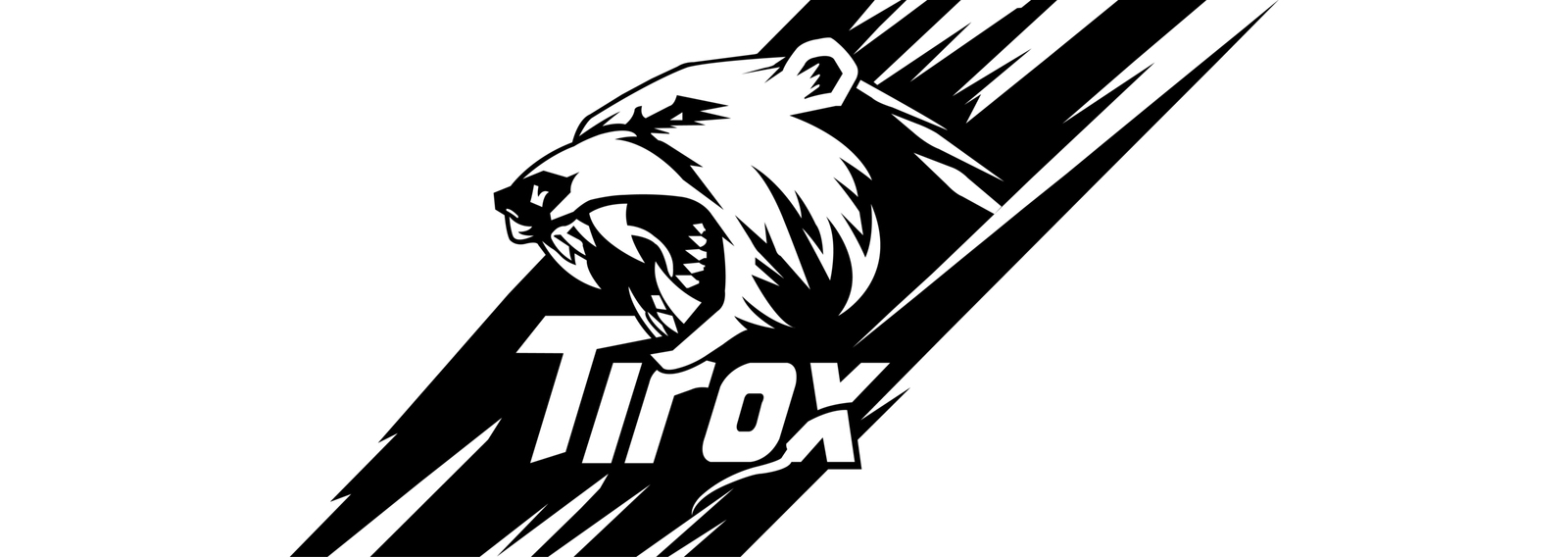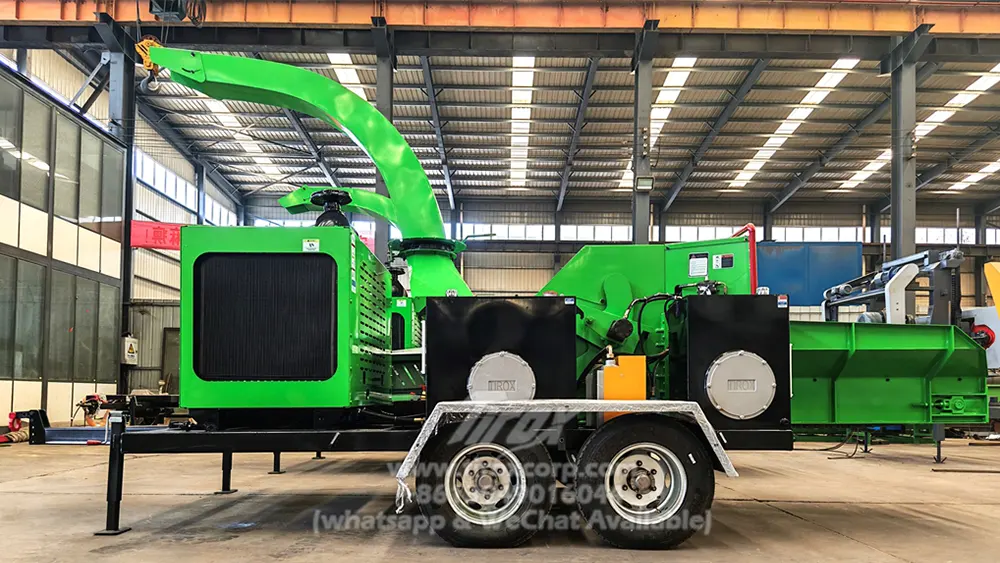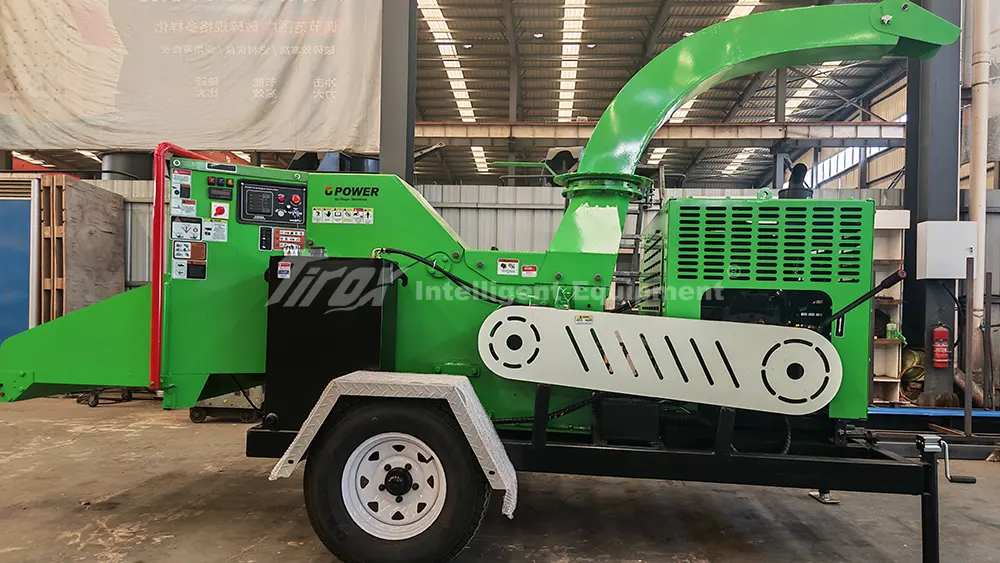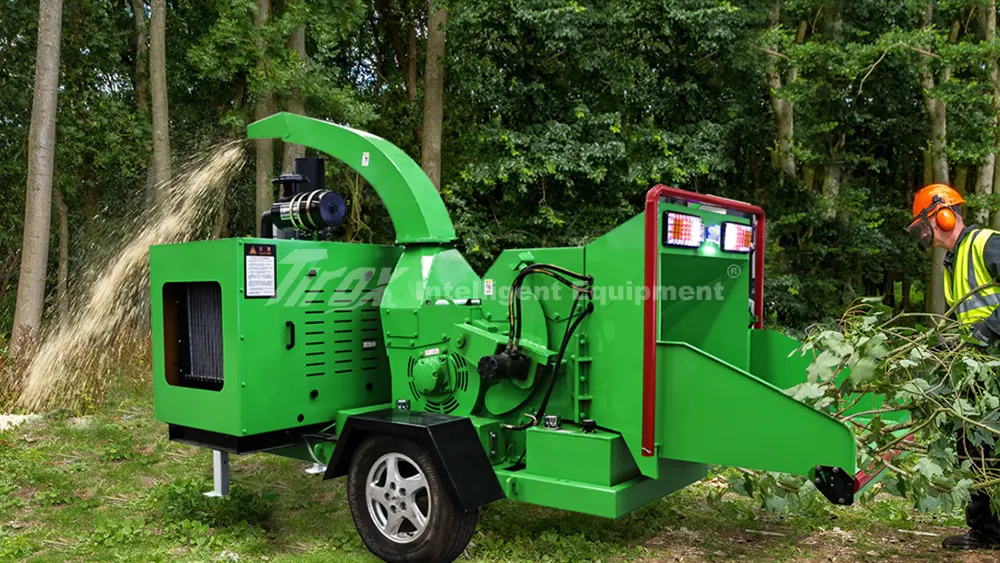
Introduction to Wood Chippers
Wood chippers are essential tools in modern landscaping and yard maintenance, designed to safely reduce branches, leaves, and other organic waste into smaller, manageable pieces. Their primary function is to facilitate the efficient disposal of yard debris, enabling homeowners and professionals alike to enhance the aesthetics of their outdoor spaces while simultaneously promoting environmental sustainability. By converting larger materials into mulch or wood chips, these machines help in creating an organic recycling loop that benefits the soil and surrounding plants.
The operation of a wood chipper is fairly straightforward. The device typically consists of a feed chute, a rotating blade, and a collection receptacle. When branches or plant debris are fed into the chute, the sharp blades rapidly shred the materials into smaller fragments. This not only reduces the volume of waste but also prepares it for use as mulch, compost, or garden bedding. By turning yard waste into valuable organic material, wood chippers play a vital role in waste reduction and contribute to a more sustainable approach to lawn care.
Understanding the capabilities and limitations of wood chippers is crucial for safe operation. It is vital to know which materials can be safely processed to avoid damaging the machine or causing potential hazards. Not all organic matter is suitable for chipping; for instance, certain hard woods and non-organic materials must be avoided. This blog post will delve deeper into the types of materials that should and should not be fed into a wood chipper, ensuring that users can operate these machines effectively and safely. With responsible usage, wood chippers can significantly ease the burden of yard maintenance while promoting environmental stewardship.
Common Materials Suitable for Wood Chippers
When operating a wood chipper, it is crucial to recognize the specific materials that are deemed safe for processing. Wood chippers are designed primarily to handle organic plant matter, which typically includes various types of branches, leaves, and wood, making them ideal tools for yard cleanup and landscaping tasks.
The most common materials suitable for wood chippers include freshly cut branches and limbs. These branches should ideally measure between 1 inch and 6 inches in diameter to ensure optimal performance and prevent potential clogging. It is beneficial to work with softwood species, such as pine, spruce, or fir, as they tend to chip more easily compared to hardwoods. However, hardwood branches, like those from oak or maple, can also be processed if they are not excessively large.
In addition to branches, leaves are another material that wood chippers can effectively process. Chipping leaves not only helps to reduce their volume but also creates valuable mulch that can be used in gardens or flower beds. It is important to ensure that the leaves are dry and not overly compacted, as wet leaves can lead to jams within the machine.
Wood chunks and smaller wood debris are additional materials suitable for wood chippers. However, it is advisable to keep the size manageable, ensuring that no piece exceeds the chipper’s specified capacity. Tree bark can typically be included in the chipping process as well, but it is wise to introduce it in moderation to avoid overwhelming the machine.
Overall, understanding the types of materials that are appropriate for wood chippers not only enhances efficiency but also prolongs the lifespan of the machine. Proper usage ensures that it operates effectively and safely, allowing for efficient yard maintenance and waste management.
Items That Should Never Be Chipped
When operating a wood chipper, it is essential to understand what materials should never be fed into the machine. Using inappropriate items not only poses risks to the machine itself but can also endanger the operator and others nearby. To ensure safety and equipment longevity, there are several prohibited items that users must avoid.
Firstly, one of the most critical categories of items to avoid is metal. This includes nails, screws, or any other fasteners that may be embedded in the wood. Feeding metal into a wood chipper can result in significant damage to the blades, leading to costly repairs or even rendering the machine inoperable. Additionally, metal can create dangerous flying debris, which poses a substantial risk to those operating or standing near the chipper.
Furthermore, plastic materials, including plastic bags and bottles, should never be fed into a wood chipper. These items can get caught in the mechanism, leading to clogs or malfunctions within the machine. More importantly, plastic is not biodegradable, so shredding it creates waste that cannot be effectively processed through standard composting methods.
Another category that should be strictly avoided is treated or painted wood. This type of wood often contains chemicals and preservatives that can be released into the environment when chipped. Furthermore, these substances can harm the machinery, leading to potential breakdowns and expensive repairs. Additionally, certain hardwoods, such as oak or dense species, may not chip well and could be harmful to the machine.
Lastly, items such as branches with large knots, stones, or any type of foliage that exceeds the machine’s limits should not be included in the feed. These materials can cause blockage, leading to increased strain on the motor and compromising safety. By adhering to these guidelines and avoiding these items, users can maintain their wood chipper’s performance and ensure safety for everyone involved.
Potential Damage to the Wood Chipper
Utilizing a wood chipper for yard maintenance is a practical and efficient choice, but improper usage can lead to significant issues. One of the primary concerns is the potential damage to the wood chipper itself. When inappropriate materials are fed into the machine, the consequences can be severe and manifold, impacting various components including the blades, motor, and overall machinery.
The blades are particularly vulnerable; designed to shred branches and organic matter, they can easily become dull or, worse, damaged when confronted with hard materials such as metal, rocks, or even certain types of plastics. This not only hampers the machine’s efficiency but can also necessitate expensive replacements or sharpening services, leading to operational downtime.
Similarly, the motor of the wood chipper can experience undue stress when fed unsuitable items. Materials that are excessively dense or fibrous, such as palm fronds, can cause the motor to overheat or even burn out. As the motor struggles to process these inappropriate items, it may draw excessive power, further exacerbating the problem. Such failures can lead to costly repairs and a complete halt in gardening activities until the machine is back in working order.
Beyond the immediate damage to the wood chipper, feeding incorrect items into the machine can also pose safety risks. Flying debris or sudden mechanical failures may result in operator injury or damage to surrounding property. Therefore, it is crucial to adhere to the manufacturer’s guidelines and understand the limitations of what can safely be fed into the wood chipper. This awareness not only preserves the integrity of the machinery but also ensures a safer working environment. Proper maintenance and appropriate material disposal play a vital role in the longevity and effectiveness of wood chippers in landscaping tasks.
Safety Risks for Users
Using a wood chipper can be an efficient way to dispose of yard waste, but it also involves significant safety risks, especially when not operated correctly. One of the primary dangers associated with improper use of a wood chipper is the potential for personal injury. Operators are at risk of serious harm if they fail to follow safety protocols or attempt to feed inappropriate materials into the machine. Items such as metal objects or large branches can cause the chipper blades to malfunction, resulting in the unexpected ejection of debris and possible injury to the user or bystanders.
Moreover, the design of wood chippers poses inherent risks. Many machines operate with powerful blades that can rapidly rotate, and standing too close while in operation can lead to severe accidents. It is crucial for users to maintain a safe distance from the machine’s feed area while it is in operation, ensuring that no loose clothing or long hair can become entangled in the moving parts. Additionally, operators should always wear appropriate personal protective equipment, including gloves, eyewear, and hearing protection, to enhance their safety while using the device.
Another substantial risk involves the presence of bystanders during operation. Family members, pets, or other individuals learning about what not to put in a wood chipper should remain at a safe distance to avoid projectiles or noise-related issues. Operators must clearly communicate when the machine is in use and establish a no-go zone around the chipper to mitigate these hazards. By adhering to established safety guidelines, the risks of severe injury associated with wood chipper operation can be significantly reduced, ensuring a safer experience for all involved.
Environmental Considerations
The use of wood chippers is often an efficient alternative for managing garden waste and other organic materials. However, improper disposal of specific materials in wood chippers can have significant negative consequences for the environment. While they are designed to handle natural wood, leaves, and branches, certain items can introduce harmful toxins into the ecosystems and thus exacerbate existing ecological concerns.
For instance, materials such as treated wood, plastics, or synthetic fibers should never be fed into a wood chipper. Treated wood often contains chemicals like arsenic, which, when chipped and dispersed, can leach into the soil and water systems, adversely affecting plant and animal life. Similarly, plastics are not biodegradable and can persist in nature for hundreds of years, posing threats to wildlife that may ingest or become entangled in the debris.
The environmental impact is further intensified when electronic waste is improperly disposed of. Components like circuit boards or batteries often contain heavy metals and other harmful substances. When shredded, these materials can release toxins that contaminate surrounding soil and waterways, leading to serious health risks for flora and fauna alike.
Responsible disposal methods are vital to safeguarding our ecosystems. Communities should promote recycling and composting programs to handle waste appropriately rather than relying on wood chippers for all types of refuse. Additionally, educating the public on what constitutes acceptable materials for wood chippers can help reduce instances of environment-harming disposal practices. Overall, a conscientious approach to waste management not only ensures the longevity of natural resources but also protects wildlife and human health by minimizing toxic exposure.
Tips for Safe Wood Chipping Practices
Operating a wood chipper can be an efficient way to manage yard waste, but safety must remain a top priority throughout the process. To ensure safe wood chipping practices, proper preparation of materials is essential. Before feeding branches or other debris into the chipper, inspect each piece for foreign objects such as metal stakes, stones, or plastic. These items can damage the equipment and pose a risk of injury. Additionally, branches should be free of large knots or defects, as these can cause jams or explosive failures within the chipper.
It is also crucial to regularly maintain the wood chipper to guarantee optimal performance and safety. Ensure that blades are sharp and in good condition, as dull blades can create dangerous situations, such as backlogs or unnecessary force being exerted. Routine checks on safety features, including emergency shut-off switches and protective covers, are necessary to confirm they function correctly. The wood chipper’s motor should also receive periodic servicing to prevent overheating or mechanical failures during operation.
Furthermore, adhering to established safety protocols is imperative when using a wood chipper. Always wear appropriate personal protective equipment, including gloves, goggles, and ear protection. It is advisable to work with a partner, ensuring that one person can monitor the surroundings while the other operates the machine. Establish a safety perimeter around the chipper to keep bystanders, especially children and pets, at a safe distance. Training all users on the proper operation of the chipper can help prevent accidents and enhance overall safety practices. By following these guidelines, individuals can enjoy a more secure wood chipping experience, minimizing the risk of injury and maximizing operational efficiency.
Alternatives to Wood Chipping for Non-Compatible Materials
When faced with materials that are incompatible with a wood chipper, it is essential to explore alternative disposal methods that are environmentally friendly and efficient. Various options can accommodate different materials, ensuring that waste is handled responsibly and sustainably.
One of the preferred alternatives is recycling. Many materials, such as plastics, metals, and paper products, can be collected and processed at local recycling facilities. These facilities often have specific guidelines regarding what can be accepted, making it crucial to check local regulations. By choosing to recycle, individuals not only reduce landfill waste but also support the circular economy.
Composting is another effective method for disposing of organic materials that cannot be chipped. Items like food scraps, yard waste, and some types of plant material can be composted, transforming them into nutrient-rich soil. Home composting systems vary in size and complexity, from simple backyard bins to sophisticated indoor composters, making it accessible for everyone. Moreover, community composting programs may be available, allowing individuals to contribute to local soil health and reduce waste.
For non-wood materials such as textiles, appliances, and electronics, local waste disposal facilities are a viable option. Many communities offer designated drop-off locations for specific types of waste. Facilities often include hazardous waste collections for items like batteries or paint, ensuring that such materials do not harm the environment.
Exploring these alternatives ensures that incompatible materials are disposed of in a way that aligns with environmental sustainability goals. Whether through recycling, composting, or proper waste disposal, individuals can take proactive steps to protect natural resources and minimize ecological impact.
Conclusion and Final Thoughts
Understanding what not to put in a wood chipper is crucial for ensuring both safety and the longevity of this essential yard maintenance tool. Wood chippers are designed to process organic waste, but misuse can lead to significant hazards. Items such as metal objects, treated wood, and large branches can not only obstruct the machine’s functionality but may also pose risks of injury to the operator and bystanders. Therefore, familiarizing oneself with the specific guidelines provided by the manufacturer is imperative.
It is essential to prioritize the maintenance of your wood chipper by adhering to safety protocols, as improper usage can lead to costly repairs or accidents. When considering the ideal materials for chipping, focus on untreated and dry wood along with smaller branches to ensure optimal performance. Avoid items that can compromise the blades, such as plastic, glass, or any non-organic matter. Engaging in proper yard maintenance should not only be about efficiency but also about protecting oneself and preserving the equipment.
Furthermore, regularly inspecting the wood chipper for wear and tear can prevent malfunctions during operation. Keeping the blades sharp and in good condition allows for better performance and reduces the risk of jams. Understanding the boundaries of what your wood chipper can handle is not only a best practice but a fundamental aspect of responsible equipment use.
In conclusion, reinforcing the awareness of what not to put in a wood chipper is vital for effective yard maintenance. Adopting a conscientious approach to using this equipment will contribute to safer and more productive outdoor work experiences. By implementing these practices, both novices and experienced users can enhance their operational efficiency while ensuring safety remains a top priority.






